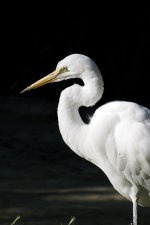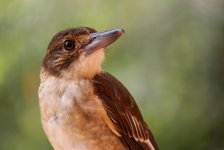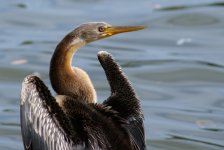Hi,
Thanks to everyone who looked at and commented on my photos - all feedback is most appreciated.
It looks like the main areas of comment turned out to be exposure, aperture, and composition.
In terms of exposure, I would agree that they are a little over exposed, especially the egret. It is definately an area I need to work on, although I am still quite pleased with how the egret turned out (my previous attempts at a white bird on a dark background have been less successful than this one). Blown highlights seem to go hand in hand with the strong sunlight in Australia! Everything seemed to look glowy. But, it's useful to keep in mind that slightly under exposed is better than slightly over.
In terms of aperture, changing the f stop would have given me more of the bird in focus in the second shot. I was probably playing it a bit too safe in order to keep the background nice and out of focus. The background actually wasn't as far away as it seems. As a result, the back of the bird's head, and tip of his beak is out of focus. I don't find this too distracting, but it would have been better if they had been sharp. I actually took loads of photos of this little fella, including shots where he is completely in focus, but for some reason, this shot remains my favourite of the group, even though it is technically not as good. Perhaps I just like his cheeky expression? I am hesitant to raise the ISO to 400 as my camera is very fussy and can make a photo appear suprisingly noisy at such low ISO. I am hoping to upgrade to a better model soon and I think I will have more scope to play with ISO.
Joespy - I love that you think bird number 3 "looks peculiar in that the head doesn't look to be a part of the rest of it". So true! It looks totally weird and that's why I love this photo. It's neck is like an uncoiling snake! Kennethwfd - The head and beak are actually in focus, but for some reason, the plumage of Darters always seems to make them look a bit fuzzy.
In terms of the composition, I am experimenting a bit. Obviously, they are not what is regarded as 'normal', and are not everybody's cup of tea, but as Peter Jones kindly points out, they make a "nice change from side on portraits and headshots", and that was basically my intention. I am trying to find a way of photographing birds without getting stuck in a rut early on in terms of framing. I am exploring whether I can create a photo that is aethetically pleasing without adhearing religiously to established conventions. I promise I am not trying to be difficult! I am just testing the waters. I have the usual close up headshots and full length shots too but I chose not to post them here because you have seen that sort of thing before, right? And done much better too!
With the egret, I didn't like the little tufts of grass at the bottom of the picture originally, and cloned them out. But the picture actually felt more unbalanced without them, and so I put them back in! I found that the tufts of grass kind of mirrored the little tuft of feathers on the back of the bird.
Joespy and DaveAitch: Yes, these photos would make poor record or scientific shots. I am more into capturing the character of a bird. I think I frame them the way I do because (broadly speaking) I find a headshot to be a bit stiflingly close, and a full length shot to be too far away and impersonal.
So here's the question... Is it of any benefit to play around with the rules of photography? Do I stick with my odd framing technique at the risk of the photo looking 'wrong' to the majority of people, or do I need to become more conventional? (I can't decide).







